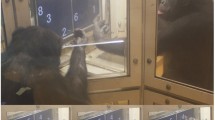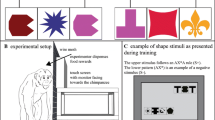Abstract
I report spontaneous spatial object grouping in five chimpanzees (Pan troglodytes)ranging from 1 to 4 years of age. I recorded subjects' spontaneous interactions with groups of objects, noting the spatial relations in the groupings and the constructive processes that the subjects adopted. Though one subject developed vertical stacks, none of them realized horizontal alignments or spatial correspondences between groups. All subjects showed consistent trends in their constructive processes toward manipulating objects in relation to the body: they increasingly manipulated objects globally, that is to say, they moved or held objects together with the same part of the body. They also increasingly placed objects on the body or in correspondence to their symmetrical body parts. The increasing importance assigned by chimpanzees to body- object relations over object- object relations contrasts with human developmental trends in the domain of manipulative space.
Similar content being viewed by others
References
Antinucci, F. (ed.) (1989).Cognitive Structure and Development in Nonhuman Primates, Lawrence Erlbaum, Hillsdale.
Bayley, N. (1969).Bayley Scales of Infant Development, The Psychological Corporation, New York.
Boysen, S. T., and Bernston, G. G. (1990). The development of numerical skills in the chimpanzee (Pan troglodytes). In Parker, S. T., and Gibson, K. (eds.), “Language”and Intelligence in Monkeys and Apes: Comparative Developmental Perspectives, Cambridge University Press, Cambridge.
Chevalier-Skolnikoff, S. (1977). A Piagetian model for describing and comparing socialization in monkey, ape and human infant. In Chevalier-Skolnikoff, S., and Poirier, F. (eds.),Primate Bio-social Development: Biological, Social and Ecological Determinant, Garland Press, New York, pp. 159–187.
Chevalier-Skolnikoff, S. (1983). Sensorimotor development in orang-utans and other primates.J. Hum. Evol. 12: 545–561.
Doré, F. Y., and Dumas, C. (1987). Psychology of animal cognition:-Piagetian studies.Psychol. Bull 102: 219–233.
Forman, G. E. (1982).Action and Thought, Academic Press, New York.
Gesell, A. (1940).The First Five Years of Life, Harper & Brothers, New York.
Greenfield, P. M. (1991). Language, tools and brain: The ontogeny and phylogeny of hierarchically organized sequential behavior.Behav. Brain Sci 14: 531–595.
Guanella, F. M. (1934). Block building activities of young children.Arch, Psychol. 174: 5–92.
Hallock, M. B., and Worobey, J. (1984). Cognitive development in Chimpanzee infants(Pan troglodytes).J. Hum. Evol. 13: 441–447.
Harris, P. L. (1983). Infant Cognition. In Mussen, P. H. (ed.),Handbook of Child Psychology, Wiley, New York.
Kohler, W. (1976).The Mentality of Apes, Liveright, New York (original work published in 1925).
Langer, J. (1980).The Origins of Logic: Six to Twelve Months, Academic Press, New York.
Langer, J. (1986).The Origins of Logic: One to Two Years, Academic Press, New York.
Langer, J. (1993). Infants' developing manipulatory and classificatory behavior, Unpublished manuscript.
Langer, J. (1994). Logic. In Ramachandran, V. S. (ed.),Encyclopedia of Human Behavior, Academic Press, San Diego.
Limongelli, L., Boysen, S. T., and Visalberghi, E. (1995). Comprehension of cause-effect relationships in a tool-using task by chimpanzees(Pan troglodytes).J. Comp. Psychol. 109(1): 18–26.
Marascuilo, L. A., and McSweeney, M. (1977).Nonparametric and Distribution Free Methods for the Social Sciences, Brooks/Cole, Monterey, CA.
Mathieu, M., Daudelin, N., Dagenais, Y., and Decarie, T. (1980) Piagetian causality in two housed-reared chimpanzees(Pan troglodytes).Can. J. Psychol. 34: 179–185.
Matsuzawa, T. (1989). Spontaneous pattern construction in a chimpanzee. In Heltne, P., and Margardt, L. (eds.),Understanding Chimpanzees, Harvard University Press, Cambridge, MA.
Matsuzawa, T. (1990). Spontaneous sorting in human and chimpanzee. In Parker, S. T., and Gibson, K. (eds.),“Language” and Intelligence in Monkeys and Apes: Comparative Developmental Perspectives, Cambridge University Press, Cambridge.
Matsuzawa, T. (1991). Comment to Greenfield, P. M.Behav. Brain Sci. 14(4): 570.
Mignault, C. (1985). Transition between sensorimotor and symbolic activities in nursery-reared chimpanzees(Pan troglodytes).J. Hum. Evol. 14: 747–758.
Natale, F., and Spinozzi, G. (1985). Interazione tra prensione e locomozione nello sviluppo cognitivo di un macaco (Interaction between prehension and locomotion in the cognitive development of a macaque).Giornale Hal Psicol. XII-2: 269–285.
Parker, S. T. (1977). Piagetian sensorimotor series in an infant macaque: A model for comparing unstereotyped behavior and intelligence in human and nonhuman primates. In Chevalier-Skolnikoff, S., and Poirier, F. (eds.),Primate Bio-social Development- Biological, Social and Ecological Determinants, Garland Press, New York, pp. 159–187.
Parker, S. T., and Gibson, K. (eds.) (1990).“Language” and Intelligence in Monkeys and Apes: Comparative Developmental Perspectives, Cambridge University Press, Cambridge.
Piaget, J. (1971).The Construction of Reality in the Child, Ballantine Books, New York (original work published 1937).
Piaget, J. (1970).Genetic Epistemology (E. Duckworth, trans.), Columbia University Press, New York.
Piaget, J. (1974).The origins of intelligence in children (M. Cook, trans.). International University Press, New York (original work published 1936).
Piaget, J., and Szeminska, A. (1941).La genese du nombre chez l'enfant, Delachaux & Niestle, Neuchatel.
Pick, H. L., and Lockman, J. J. (1981). From frames of reference to spatial representation. In Liben, L. S., Patterson, A. H., and Newcombe, N. (eds),Spatial Representation and Behavior Across the Life Span, Academic Press, New York, pp. 39–61.
Potì, P. (1989). Early sensorimotor development in macaques. In Antinucci, F. (ed.),Cognitive Structure and Development in Nonhuman Primates, Lawrence Erlbaum, Hillsdale, NJ., pp. 39–53.
Potì, P., and Spinozzi, G. (1994). Early sensorimotor development in chimpanzees(Pan troglodytes).J. Comp. Psychol 108(1): 93–103.
Premack, D., and Premack, A. J. (1983).The Mind of an Ape, W. W. Norton, New York.
Savage-Rumbaugh, E. S. (1986).Ape Language, Columbia University Press, New York.
Siegel, S. (1956).Nonparametric Statistics for the Behavioral Sciences, McGraw-Hill, New York.
Sigel, I. E., Secrist, A., and Fonnan, G. (1973). Psycho-educational intervention beginning at age two: Reflections and outcomes. In Stanley, J. (ed.),Compensatory Education for Children, Ages 2 to 8, Johns Hopkins Press, Baltimore.
Spinozzi, G. (1989). Early sensorimotor development inCebus (C. apella). In Antinucci, F. (ed.),Cognitive Structure and Development in Nonhuman Primates, Lawrence Erlbaum, Hillsdale, NJ, pp. 55–66.
Spinozzi, G. (1993). Development of Spontaneous Classificatory Behavior in Chimpanzees(Pan troglodytes).J. Comp. Psychol 107(2): 193–200.
Spinozzi, G., and Natale, F. (1989). Early sensorimotor development in Gorilla. In Antinucci, F. (ed.),Cognitive Structure and Development in Nonhuman Primates, Lawrence Erlbaum, Hillsdale, NJ, pp. 21–38.
Spinozzi, G., and Potf, P. (1993). Piagetian stage 5 in two chimpanzee infants (Pan troglodytes): The development of permanence of objects and the spazialization of causality.Int. J. Primatol. 14: 905–917.
Stiles-Davis, J. (1988). developmental change in young children's grouping activity.Dev. Psychol 24: 522–531.
Sugarman, S. (1983).Children's Early Thought: Developments in Classification, Cambridge University Press, Cambridge, MA.
Vauclair, J. (1984). Phylogenetic approach to object manipulaiton in human and ape infants.Hum. Dev. 27: 321–328.
Vauclair, J., and Bard, K. A. (1983). Development of manipulations with objects in ape and human infants.J. Hum. Evol. 12: 631–645.
Visalberghi, E., Fragaszy, D. M., and Savage-Rumbaugh, S. (1995). Performance in a tool-using task by common chimpanzees(Pan troglodytes), bonobos(Pan paniscus), an orangutan(Pongo pygmaeus), and capuchin monkeys(Cebus apella).J. Comp. Psychol 109(1): 52–60.
Author information
Authors and Affiliations
Rights and permissions
About this article
Cite this article
Potì, P. Spatial aspects of spontaneous object grouping by young chimpanzees(Pan troglodytes) . International Journal of Primatology 17, 101–116 (1996). https://doi.org/10.1007/BF02696161
Received:
Accepted:
Issue Date:
DOI: https://doi.org/10.1007/BF02696161




